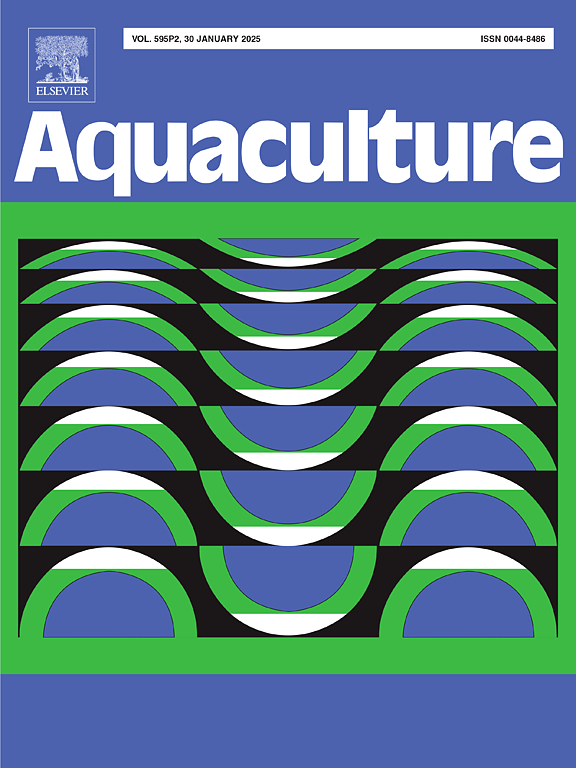The multi-omics approach reveals the impact of Temnocephala digitata infection on Macrobrachium rosenbergii
IF 3.9
1区 农林科学
Q1 FISHERIES
引用次数: 0
Abstract
Macrobrachium rosenbergii (M. rosenbergii) is a vital freshwater economic species, and no prior reports exist on its infection by the symbiotic flatworm Temnocephala digitata (Platyhelminthes: Temnocephalidae; T. digitata). However, during aquaculture practices, we observed that T. digitata infection caused growth retardation and even mortality in M. rosenbergii. This study investigates the pathogenic mechanisms of T. digitata infection in M. rosenbergii using a multi-omics approach. Results revealed that T. digitata infection induced growth retardation, immune suppression, and metabolic dysregulation in the shrimp. Intestinal microbiota analysis demonstrated microbial dysbiosis characterized by an increased abundance of Proteobacteria (particularly the opportunistic pathogenic genus Aeromonas) and reduced proportions of Firmicutes and Bacteroidota. Integrated transcriptomic and metabolomic analyses showed that T. digitata infection suppressed ribosomal functions, lipid metabolism, and protein metabolism in gill tissues while concurrently activating inflammatory factors and pathways (e.g., TNF-α, COX-2, and Toll/IMD signaling). Additionally, infection induced abnormal molting behavior by upregulating ecdysone (ECD), and methyl farnesoate (MF) while suppressing molt-inhibiting hormone (MIH), exacerbating energy depletion and immune exhaustion. Multi-omics correlation analysis further elucidated complex interactions among core gut microbiota, key metabolites, and hub genes, collectively driving nutrient-immune imbalance. Histopathological examinations confirmed hepatopancreatic vacuolization, intestinal villi atrophy, and gill lesions, consistent with metabolic and immune dysfunction. This study provides the first evidence of T. digitata-associated pathogenicity in M. rosenbergii, revealing that the symbiont-host interaction disrupts nutrient metabolism-immune homeostasis, thereby precipitating a health crisis. These findings advance understanding of temnocephalid-crustacean relationships and highlight risks of symbiont overproliferation in aquaculture systems.
多组学方法揭示了数字Temnocephala感染对罗氏沼虾(Macrobrachium rosenbergii)的影响
罗氏沼虾(Macrobrachium rosenbergii, M. rosenbergii)是一种重要的淡水经济物种,目前尚无关于其被共生扁形虫Temnocephala digitata感染的报道。t . digitata)。然而,在养殖实践中,我们观察到数字绦虫感染会导致罗氏沼虾生长迟缓甚至死亡。本研究采用多组学方法研究罗森氏螺旋体感染的致病机制。结果表明,纵沟沟绦虫感染可引起对虾生长迟缓、免疫抑制和代谢失调。肠道菌群分析显示,微生物生态失调的特点是变形菌门(特别是机会致病性气单胞菌属)的丰度增加,厚壁菌门和拟杆菌门的比例减少。综合转录组学和代谢组学分析显示,digitata感染抑制了鳃组织的核糖体功能、脂质代谢和蛋白质代谢,同时激活了炎症因子和途径(如TNF-α、COX-2和Toll/IMD信号)。此外,感染通过上调蜕皮激素(ECD)和法尼酸甲酯(MF),抑制蜕皮抑制激素(MIH),加剧能量消耗和免疫衰竭,诱导异常蜕皮行为。多组学相关分析进一步阐明了核心肠道菌群、关键代谢物和枢纽基因之间复杂的相互作用,共同驱动营养-免疫失衡。组织病理学检查证实肝胰腺空泡化、肠绒毛萎缩和鳃病变,符合代谢和免疫功能障碍。该研究首次提供了与数字t相关的罗氏分枝杆菌致病性的证据,揭示了共生体-宿主相互作用破坏营养代谢-免疫稳态,从而引发健康危机。这些发现促进了对temnocephala -甲壳类动物关系的理解,并突出了水产养殖系统中共生过度增殖的风险。
本文章由计算机程序翻译,如有差异,请以英文原文为准。
求助全文
约1分钟内获得全文
求助全文
来源期刊

Aquaculture
农林科学-海洋与淡水生物学
CiteScore
8.60
自引率
17.80%
发文量
1246
审稿时长
56 days
期刊介绍:
Aquaculture is an international journal for the exploration, improvement and management of all freshwater and marine food resources. It publishes novel and innovative research of world-wide interest on farming of aquatic organisms, which includes finfish, mollusks, crustaceans and aquatic plants for human consumption. Research on ornamentals is not a focus of the Journal. Aquaculture only publishes papers with a clear relevance to improving aquaculture practices or a potential application.
 求助内容:
求助内容: 应助结果提醒方式:
应助结果提醒方式:


